-

人教版高中英语必修2Computers说课稿3篇
一. 教材分析1. 本单元的中心话题是“计算机(Computers)”,内容涉及计算机的发展历史,计算机的应用等。本节课是该单元的第一课时,我将Warming up, Pre-reading and Comprehending这四部分整合为一节精读课。其中。Reading部分是题为WHO AM I?的文章,以第一人称的拟人手法介绍了计算机发长演变的历史和计算机在各个领域的应用,其主旨是表达计算机的发展变化之快以及在生活中用途之广。而Warming up部分以图片的形式展现了计算机的发展历程;Pre-reading中的问题和排序分别是为了预测语篇的内容和测试学生对计算机历史了解的情况;Comprehending则通过各项练习训练学生的阅读技能,从而加深对文章的理解。可见这几部分是一个有机的整体。2. 教学目标:1) 语言目标:重点词汇及短语:abacus, calculate, calculator, PC, laptop, PDA, robot, analytical, technological, universal, mathematical, artificial, intelligent, network, explore, in common, as a result.重点句子:a. My real father was Alan Turing, who in 1963 wrote a book to describe how computers could be made to work, and build a “universal machine” to solve any mathematical problem.

人教版高中英语必修2Cultural Relics说课稿2篇
Ⅲ. Analysis of the teaching material:The topic of this unit is cultural relics. Students are quite interested in topics about different cultures around the world. This is the second period of the whole unit. As a reading class, the passage mainly talks about the history of the amber room (how it was made, sent as a gift, lost and rebuilt).According to the new national curriculum, when teaching reading, much emphasis should be put on training the students’ reading skills.Ⅳ. Teaching objectives1. Language objectives:1) Students are required to master the key words and phrases occurred in the passage (e.g. amazing, decorate, belong, in return, less than etc.)2) Students are required to learn the attributive clause and acquire the sentence pattern.2. 1) Students are required to describe a certain thing by using the new sentence patterns.2) Students are required to master two kinds of reading skills—skimming and scanning, and learn to use them in their daily reading.3. 1) Students are required to know the history of the amber room.2) Students are required to appreciate cultural relics and understand the importance of protecting them.Ⅴ. Teaching important and difficult points1) the new words, phrases, and sentence pattern in the course of reading.2) Teaching difficult point: Help the students master two kinds of reading skills—skimmingand scanning and learn to apply them in daily use.Ⅵ. Teaching methods:Task-based method & Top-down model Ⅶ. Teaching aids: PPT, pictures, blackboard Ⅷ. Teaching procedure:

人教版高中英语必修2Wildlife Protection说课稿3篇
When it comes to the students’ studying methods, I'd like to introduce my Ss first. The Ss have a good command of basic language points. They’re interested in learning English, and they take an active part in English class, so they will have fun in autonomous, cooperative and inquiry learning. I will just serve as a guide, showing them the way to explore how to make more progress in their English learning.Now it’s time for the most important stage of this lesson. My teaching procedures are arranged as follows:Step1.Leading-in (3 minute)Play a video of a wide variety of wildlife to introduce my topic. Step2. Speaking (12 minutes)We will use our textbook Page25. Let the Ss fast read the short paragraph to warm up. Ask them to talk about the report on some endangered wildlife in China with the dialogue patterns on the screen. Lastly, I will invite some groups to demonstrate their dialogues about saving wildlife in China.Step3.English play (3 minutes)Watch another video in praise of their excellent performance just now. It’s about Jack Chen’s(成龙)and Yang Ziqiong’s wildlife protection.Step4. Listening (twice 13 minutes)This time, I’ll ask the Ss to fill in the blanks of the monologue of the 2 movie stars above. Step5.Discussion (3 minutes)Which would you like to choose to wear, clothes made of cotton, artificial leather or animal skins? Why ?Step6. Summary (3 minutes)1. If there were no wildlife, there wouldn’t exist human beings. If the buying stops, the killing can, too.2. Animals are our friends. To love animals is to love ourselves. Stop hunting, killing and destroying wildlife.3. Let’s live in harmony with all the living things in the world. Step7. Music appreciation (3 minutes)Let the Ss appreciate the song Earth Song by Michael Jackson. Last but not the least, I will show you my blackboard design.

人教版高中英语必修4Women of achievement说课稿4篇
Good morning, distinguished judges:It’s my honor to talk about my teaching ideas with you. Today my topic is Women of Achievement. My presentation consists of six parts: the analysis of teaching material and student, teaching aims, key and difficult points, teaching and studying method, teaching procedures and blackboard design.First, let’s focus on the analysis of teaching material. This lesson is from New Senior English for China Student’s Book 4 Unit 1, the reading part. The main topic of the passage is the introduction of a student of Africanwildlife. After this lesson, the students will learn more information about her studying chimps in Africa, and their reading and speaking abilities can be developed as well.The next part is the analysis of students. My students are in senior high students. They have learnt English for many years, they’ve known many words and sentences, but their speaking and reading abilities are still not very good. So I will practice their speaking and reading abilities through different exercises.According to the New Standard Curriculum and the present situation, I set the teaching aims as follows: firstly, knowledge aims. Students can grasp some new words, such as worthwhile, move off. Moreover, students can understand the content of the passage and get familiar with the topic of studying chimps in wildlife. Secondly, ability aims. Students can use reading strategies such as skimming and scanning in reading process. Thirdly, emotional aims. Students can have the awareness of protecting animals and care about animals.Based on the above analysis, the key point of this lesson is to get the main idea and the detailed information from the passage; the difficult point is to talk about the wildlife protection and use reading strategies.

人教版高中英语必修3Healthy Eating说课稿4篇
Language learning needs a context, which can help the learners to understand the language and then can product comprehensible output, so computer has the advantages to make the materials attractive.Part 3 Learning MethodsTask-based, self-dependent and cooperative learningPart 4 Teaching ProcedureStep One Lead-in“Interest is the best teacher.” Therefore, at the very beginning of the class, I should spark the students’ mind to focus on the centre topic “the band”. I’ll show some pictures of food to attract their attention and then bring some questions.Question:What kind of food they like?What should go into a good meal?The answers must relate to the diet. After this, the students will be eager to know something about a balance diet and this is the very time to naturally lead the class into Step 2Step 2 Reading for information: skimming and scanning In this step, I use Task-based Language Teaching method, which can give students a clear and specific purpose while skimming and scanning the context.Task 1 General ideaThe students will be asked to just glance at the title and the pictures of the passage, and then guess what they will read in the text. And they’ll be divided into groups of four to have a discussion.The purpose is to inspire the students to read actively, not passively. In addition, the task is to develop the students’ reading skill by making prediction and to encourage the students to express their thoughts in English and cooperate with each other.Task 2 Main idea of each paragraphCooperative learning can raise the students’ interest and create an atmosphere of achievement. Based on this theory, I divide the whole class into 4 groups to skim the whole text and get the main idea of each paragraph.

人教版高中英语必修5First aid说课稿6篇
In this class, I have 3 teaching aims, that is, knowledge aims, ability aims and emotion aims.1) Knowledge-Teach students new words and expressions, such as temporary, bleed,sprain choke, first aid, fall ill and so on.-Enable students to have a better understanding for some basic knowledge of first aid.2) Ability-Train students’ speaking, reading and writing abilities by different teaching activities, such as skimming, comprehending, team work, role play, retelling and writing.-Develop students’ reading strategy on how to move general idea to specific information.3) Emotion-Promote students’ awareness of giving first aid.- Cultivate students’ creativities.Then let’s come to my teaching methods and activities.III. Teaching methods and activities:To achieve different teaching aims, various kinds of teaching methods and activities will be adopted throughout this period, such as TBL (task-based learning), skimming, team work, brainstorm and others, which can offer students opportunities to fulfill tasks in which they can use language to achieve a specific outcome.IV. Teaching aids:Computer and blackboardV. Teaching important points:1) Make students have a clear mind for the structure of the text.2) Help students understand the theme of the text.VI. Teaching difficulties:1) So many new words may affect students’ understanding.2) How to get students to know about the functions of the skin and thecauses, characteristics and treatments for different degree burns,and the knowledge about giving first aid. VII. Blackboard design:

人教版高中英语必修5Making the news说课稿4篇
今天我们来介绍一下必修五第四单元的授课方式。这个单元的题目是Making the news。应该是学生比较感兴趣的话题,学生往往对新闻工作充满好奇,所以我们可以利用这个机会多设计一些师生互动和学生互动,来激发起学习的积极性,提高学习效率。同时我们可以利用这个单元不仅帮助学生掌握语言知识,培养语言能力,同时让其了解新闻工作的重要性,培养起社会智能感。这个单元分为六个课时,它的教学目标是这样的:语言目标是掌握词汇表中的常用单词和短语,掌握倒装句的一些基本用法。 技能目标是能初步掌握约会的基本句型并在真实的场景下正确运用。新闻报道类文章的写作技能。采访的基本规范和沟通技能。情感目标是对新闻报道的客观性和真实性有更好的理解。对新闻记者的职业有更深入的了解,并能体会其工作的重要性。下面我们来介绍一下第一课时的授课方式,第一课的教学目标是这样的第一课时的教学目标语言目标:单词:Occupation, journalist, editor, photographer, curious, personality, enthusiasm
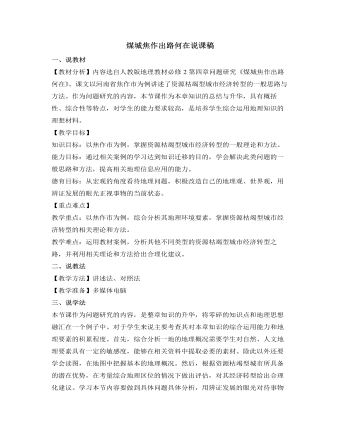
人教版高中地理必修2煤城焦作出路何在说课稿
分析过焦作市的地理概况和产业优势后,就需要针对由于资源枯竭所带来的问题提出合理化的建议。既然是谈经济转型,就应该将话题的范围明确在这一领域内。通过材料3的相关内容,我们了解到焦作市需要在产业结构调整、培育新的优势产业、增强综合竞争力等三个整改方针上下功夫。因而引导学生针对优势与不足提出建议,以三个整改方针为基准,衡量建议的可行性是锻炼学生解决此类问题的有效途径。在此我将教会学生的是解决问题方法而非案例的内容,正所谓“授之以鱼,不如授之以渔”。接下来针对学生的建议和教材资料分析所罗列的10点整改思路,由学生自由发言提出看法,通过教师的指导和学生的讨论,进而确定经济转型建议的具体方案。最后注意将建议与产业优势相对照,看建议是否都是围绕着产业优势而提出的,这样做会加深学生的印象,通过建议和优势的对应关系,将不难找出此类问题的解题思路。
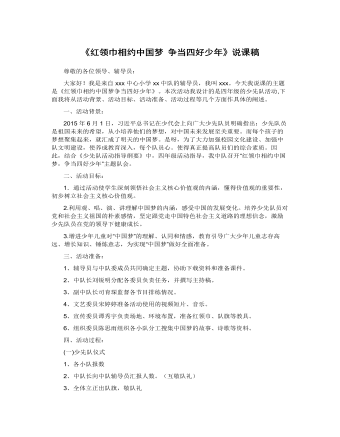
《红领巾相约中国梦 争当四好少年》说课稿
3、展梦想。第三小队通过演讲的形式,展示了自己的中国梦。队员分组通过朗诵诗歌、讲故事和演讲展示自己的中国梦,充分发表自己对社会主义核心价值观的理解,坚定争做四好少年的信心。〖设计意图:社会主义核心价值观比较抽象化,四年级的学生理解起来比较困难,让学生通过表演的形式,在某种程度上视觉感官接受要比抽象图更容易〗第三版块:深入研讨——领悟价值观看各小队表演之后,中队长启发队员们结合自身情况交流学习体会,讨论以下四个问题:(1)观看了视频和同学的表演后,你有什么感想?(2)如何学习树立自己的中国梦?(3)如何用实际行动践行社会主义核心价值观,实现自己的中国梦?让学生结合自身的特点,为自己设定合适的价值观。在此基础上让队员们齐声唱《红领巾心中飘》,道出自己心中的梦想。
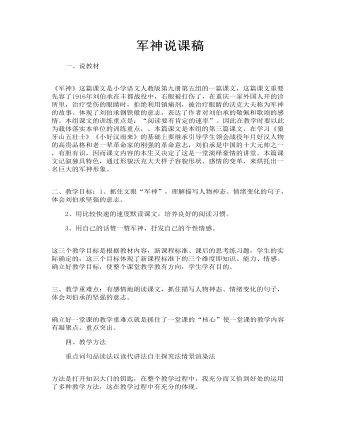
军神说课稿
二、教学目标:1、抓住文眼“军神”,理解描写人物神态、情绪变化的句子,体会刘伯承坚强的意志。 2、用比较快速的速度默读课文,培养良好的阅读习惯。 3、用自己的话赞一赞军神,抒发自己的个性情感。 这三个教学目标是根据教材内容,新课程标准、课后的思考练习题,学生的实际确定的,这三个目标体现了新课程标准下的三个维度即知识、能力、情感。确立好教学目标,使整个课堂教学教有方向,学生学有目的。 三、教学重难点:有感情地朗读课文,抓住描写人物神态、情绪变化的句子,体会刘伯承的坚强的意志。 确立好一堂课的教学重难点就是抓住了一堂课的“核心”使一堂课的教学内容有凝聚点,重点突出。 四、教学方法 重点词句品读法以读代讲法自主探究法情景渲染法 方法是打开知识大门的钥匙,在整个教学过程中,我充分而又恰到好处的运用了多种教学方法,这在教学过程中有充分的体现。

部编版语文八年级下册《马说》教案
课时分配 建议本课依据学情分课时。第一课时进行自主学习反馈及文意梳理、整体感知。第二课时进行课文具体分析的交流展示及当堂检测。可适当调节。教学目标 知识与技能 1.掌握文章中的一些重点词语的含义,积累一些文言知识。2.结合课后注释,疏通文章意思,逐步提高文言文的朗读和疏通能力。过程与方法 1.通过不同形式的朗读,理解短文所阐明的深刻道理。2.通过合作探究的学习方式,引导学生体会文章语言的精妙。情感、态度与价值观 注重对学生的情感熏陶,让学生认识封建统治者不识人才、埋没人才的昏庸,引导学生认识到在今天的优越条件下,要努力使自己成为有用之才。
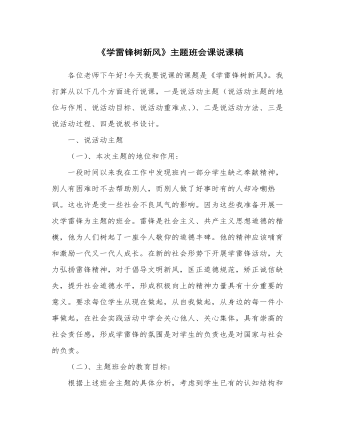
《学雷锋树新风》主题班会课说课稿
2、活动一——雷锋故事会(1)、让同学们展示课前收集的有关雷锋帮助别人的故事。使全体的同学都参与到这个活动中,发挥他们的积极性。(2)、为了丰富教育资源我在此处为学生准备了《可敬的“傻子”》、《雨夜送大嫂》、《人民的勤务员》三个故事,进行补允让学生更加全面的了解雷锋精神。设计此活动的目的是陶冶学生情操,让学生更加深入的了解勤俭朴素、助人为乐、全心全意为人民服务雷锋形象。3、活动二一一读《雷锋日记》让学生读雷锋给一位陌生老人送完手套后写的日记。重点理解“一路上,我的手虽冻得像针扎一样,心中却有一种说不出的愉快。”这一句话。让学生谈谈自己的感受。此活动的目的是让学生了解雷锋的内心世界,理解雷锋精神的实质,全心合意为人民服务。
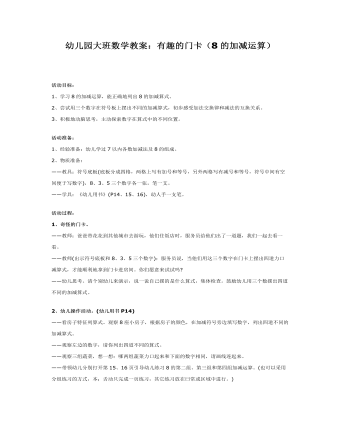
幼儿园大班数学教案:有趣的门卡
活动准备: 1、经验准备:幼儿学过7以内各数加减法及8的组成。 2、物质准备: ——教具:符号底板(底板分成四格,两格上写有加号和等号,另外两格写有减号和等号,符号中间有空间便于写数字),8、3、5三个数字各一张,笔一支。 ——学具:《幼儿用书》(P14、15、16),幼人手一支笔。活动过程: 1、奇怪的门卡。 ——教师:爸爸带花花到其他城市去游玩,他们住饭店时,服务员给他们出了一道题,我们一起去看一看。 ——教师(出示符号底板和8、3、5三个数字):服务员说,当他们用这三个数字在门卡上摆出四道力口减算式,才能顺利地拿到门卡进房间。你们愿意来试试吗? ——幼儿思考。请个别幼儿来演示,说一说自己摆的是什么算式,集体检查。鼓励幼儿用三个数摆出四道不同的加减算式。
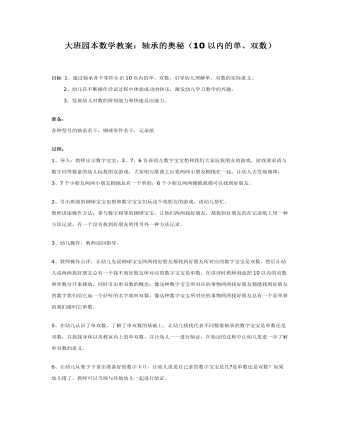
大班园本数学教案:轴承的奥秘
3、发展幼儿对数的辨别能力和快速反应能力。 准备: 各种型号的轴承若干,钢球零件若干,记录纸 过程: 1、导入:教师出示数字宝宝,3、7、6告诉幼儿数字宝宝想和我们大家玩找朋友的游戏,游戏要求请与数字同等数量的幼儿玩找朋友游戏,大家唱完歌曲之后要两两小朋友拥抱在一起。让幼儿去发现规律,3、7个小朋友两两小朋友拥抱总有一个单的,6个小朋友两两拥抱就都可以找到好朋友。 2、引出班级的钢球宝宝也想和数字宝宝们玩这个找朋友的游戏,请幼儿帮忙。 教师讲述操作方法:拿与数字相等的钢球宝宝,让他们两两找好朋友,都找到好朋友的在记录纸上用一种方法记录,有一个没有找到好朋友的用另外一种方法记录。

大班数学教案:统计我的好伙伴
本次活动让幼儿统计生日、居住楼层、家庭人口等,在上次活动中孩子们已收集了每个幼儿的基本情况并做记录,但有些孩子很快便发现这些原始资料多而杂不便记忆和记录,我紧紧抓住这一契机把问题抛给孩子,引导幼儿通过统计解决这一问题。在统计的过程中幼儿运用图画、文字、数字等符号进行记录,通过孩子们间的协商、分工、合作完成统计。由于原始资料较多加之我班幼儿对统计接触不多,故此活动将是对孩子合作能力的挑战同时也是孩子体验成功的过程。 在今天的活动中幼儿可能有争论、有矛盾,更有不足的地方,但站在孩子的发展角度,我更多的注重活动过程,注重孩子们交往能力、分工合作能力和解决问题的能力是否得到了真正提高,这才是我密切关注的问题。目的要求:1、通过统计伙伴的生日、居住楼层、家庭人口等,初步建立统计的概念2、积极寻找解决问题的方法 3、体验合作与成功的快乐。
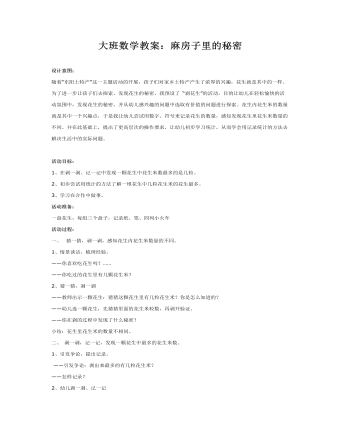
大班数学教案:麻房子里的秘密
活动目标:1、在剥一剥、记一记中发现一颗花生中花生米数最多的是几粒。2、初步尝试用统计的方法了解一堆花生中几粒花生米的花生最多。3、学习在合作中做事。活动准备:一盘花生,每组三个盘子,记录纸、笔、四列小火车活动过程:一、 猜一猜,剥一剥,感知花生内花生米数量的不同。1、情景谈话,梳理经验。——你喜欢吃花生吗?……——你吃过的花生里有几颗花生米?2、猜一猜,剥一剥——教师出示一颗花生:猜猜这颗花生里有几粒花生米?你是怎么知道的?——幼儿选一颗花生,先猜猜里面的花生米粒数,再剥开验证。——你在剥的过程中发现了什么秘密?小结:花生里花生米的数量不相同。
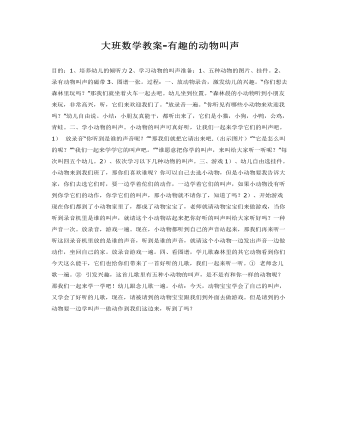
大班数学教案-有趣的动物叫声
1、培养幼儿的倾听力2、学习动物的叫声准备:1、五种动物的图片、挂件。2、录有动物叫声的磁带3、图谱一张。过程:一、放动物录音,激发幼儿的兴趣。“你们想去森林里玩吗?”那我们就坐着火车一起去吧。幼儿坐到位置。“森林晨的小动物听到小朋友来玩,非常高兴,听,它们来欢迎我们了。”放录音一遍。“你听见有哪些小动物来欢迎我吗?”幼儿自由说。小结:小朋友真能干,都听出来了,它们是小猫,小狗,小鸭,公鸡,青蛙。二、学小动物的叫声。小动物的叫声可真好听,让我们一起来学学它们的叫声吧。1) 放录音“你听到是谁的声音呢?”“那我们就把它请出来吧.(出示图片)”“它是怎么叫的呢?”“我们一起来学学它的叫声吧。”“谁愿意把你学的叫声,来叫给大家听一听呢?”每次叫四五个幼儿。2)、依次学习以下几种动物的叫声。三、游戏1)、幼儿自由选挂件。小动物来到我们班了,那你们喜欢谁呢?你可以自己去选小动物,但是小动物要我告诉大家,你们去选它们时,要一边学着佗们的动作,一边学着它们的叫声,如果小动物没有听到你学它们的动作,你学它们的叫声,那小动物就不请你了,知道了吗?
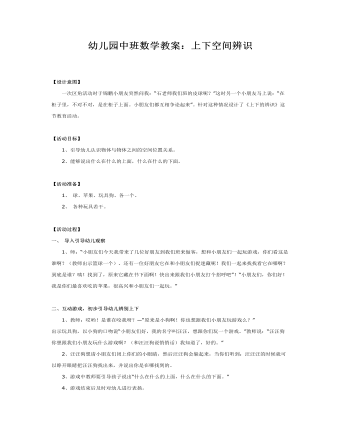
中班数学教案:上下空间的辨识
【活动目标】1、引导幼儿认识物体与物体之间的空间位置关系。2、能够说出什么在什么的上面,什么在什么的下面。 【活动准备】1、球、苹果、玩具狗、各一个。2、各种玩具若干。 【活动过程】一、导入引导幼儿观察1、师:“小朋友们今天我带来了几位好朋友到我们班来做客,想和小朋友们一起玩游戏,你们看这是谁啊?(教师出示篮球一个)。还有一位好朋友它在和小朋友们捉迷藏呢!我们一起来找找看它在哪啊?到底是谁?咦!找到了,原来它藏在书下面啊!快出来跟我们小朋友打个招呼吧”!“小朋友们,你们好!我是你们最喜欢吃的苹果,很高兴和小朋友们一起玩。”
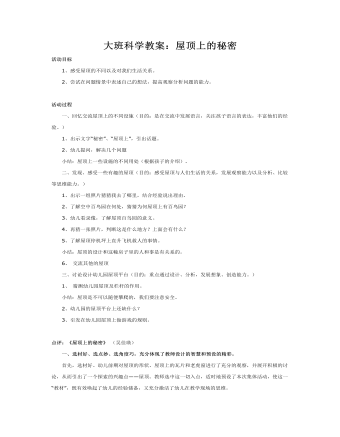
大班科学教案:屋顶上的秘密
活动过程 一、回忆交流屋顶上的不同设施(目的:是在交流中发展语言,关注孩子语言的表达,丰富他们的经验。)1、出示文字“秘密”、“屋顶上”,引出话题。2、幼儿提问,解决几个问题 小结:屋顶上一些设施的不同用处(根据孩子的介绍)。 二、发现、感受一些有趣的屋顶(目的:感受屋顶与人们生活的关系,发展观察能力以及分析、比较等思维能力。)1、出示一组照片猜猜我去了哪里,结合经验说出理由。2、了解空中百鸟园在何处,猜猜为何屋顶上有百鸟园?3、幼儿看录像,了解屋顶百鸟园的意义。4、再猜一张照片,判断这是什么地方?上面会有什么?
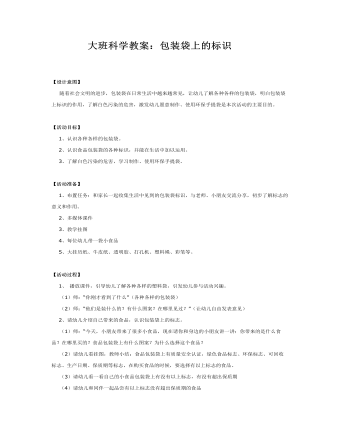
大班科学教案:包装袋上的标识
【活动目标】 1、认识各种各样的包装袋。 2、认识食品包装袋的各种标识,并能在生活中加以运用。 3、了解白色污染的危害,学习制作、使用环保手提袋。 【活动准备】 1、布置任务:和家长一起收集生活中见到的包装袋标识,与老师、小朋友交流分享,初步了解标志的意义和作用。 2、多媒体课件 3、教学挂图 4、每位幼儿带一袋小食品 5、大挂历纸、牛皮纸、透明胶、打孔机、塑料绳、彩笔等。

